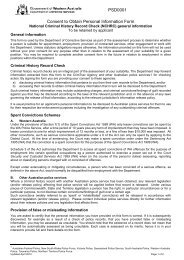Counselling Psychology Student Handbook.pdf - Health Sciences ...
Counselling Psychology Student Handbook.pdf - Health Sciences ...
Counselling Psychology Student Handbook.pdf - Health Sciences ...
- No tags were found...
You also want an ePaper? Increase the reach of your titles
YUMPU automatically turns print PDFs into web optimized ePapers that Google loves.
a) Discuss how this process manifested itself in the therapy, how you dealt with it, and theimpact on treatment. Give examples of this process in your discussion. Whereverpossible, use actual excerpts from 1 or 2 sessions to illustrate the process at work.b) Describe what, if anything, you would do differently with this client, in light of youranalysis of the therapeutic process which occurred and its impact on the client.Required readings from:• Antony, M. M & Barlow D. H. (2010). <strong>Handbook</strong> of Assessment and Treatment Planning forPsychological Disorders. (2 nd Ed). New York: Guilford Press.• American Psychiatric Association (2000). Diagnostic and statistical manual of mentaldisorders (4 th edition). Washington: American Psychiatric Association.• Bateman, A., & Fonagy, P. (2004). Psychotherapy for borderline personality disorder:Mentalization-based treatment. Oxford: Oxford University Press.• Beck, A.T., Freeman, A. Davis, D. (2004). Cognitive therapy of personality disorders (4 thEdition). New York: Guilford Press.• Commonwealth of Australia (2002). National practice standards for the mental healthworkforce. Canberra: Commonwealth of Australia.• Dimaggio, G., Semerai, A., Carcione, A., Nicolo, G., & Proacci, M. (2007). Psychotherapy ofpersonality disorders: Metacognition, states of mind and interpersonal cycles. London:Routledge.• Clark, D. A & Beck, A. T. (2010). Cognitive Therapy of Anxiety Disorders. Science andPractice. New York: Guilford Press.• Glickhauf-Hughes, C. & Wells, M. (1997). Object relations psychotherapy: An individualizedand interactive approach to diagnosis and treatment. Plymouth, UK: Jason Aronson.• *Grant, J. & Crawley, J. (2002). Transference and projection: Mirrors to the self. London:Open University Press.• Lessam, P.A. (2005). Self psychology: An introduction. Lanham: Jason Aronson.• McCullough-Vaillant, L. (1997). Changing character. Short-term anxiety-regulatingpsychotherapy for restructuring defenses, affects, and attachment. New York: Basic Books.• *McWilliams, N. (2011). Psychoanalytic diagnosis: Understanding personality structure in theclinical process (2 nd edition). New York: Guilford Press.• Millon, T. (2011). Disorders of personality: Introducing a DSM/ICD spectrum from normal toabnormal (3 rd edition). Hoboken, NJ: John Wiley.• PDM Task force. (2006). Psychodynamic Diagnostic Manual. Silver Spring, MD: Alliance ofPsychoanalytical Organizations.• Schulte-Markwort, M., Marutt, K., & Riedesser, P. (Eds). (2003). Crosswalks ICD-10-DSM-IV-TR: A synopsis of classifications of mental disorders. Gottingen, Germany: Hogrefe &Huber.• St. Clair, M. (2000). Object relations and self psychology: An introduction. Belmont,CA:Brooks/Cole• *Teyber, E. (2005). Interpersonal process in psychotherapy: A relational approach (5 thEdition). Brooks/Cole.• World <strong>Health</strong> Organisation (1992). The ICD-10 Classification of Mental and BehaviouralDisorders: Clinical Descriptions and Diagnostic Guidelines. Geneva: W.H.O.Page 52 of 88Curtin University is a trademark of Curtin University of Technology.CRICOS Provider Code 00301J (WA), 02637B (NSW)





![Mental health commission report July 2010 - June 2011 [.pdf]](https://img.yumpu.com/50755705/1/184x260/mental-health-commission-report-july-2010-june-2011-pdf.jpg?quality=85)










![2007 Annual Report [.pdf] - Health Sciences - Curtin University](https://img.yumpu.com/44476724/1/184x260/2007-annual-report-pdf-health-sciences-curtin-university.jpg?quality=85)